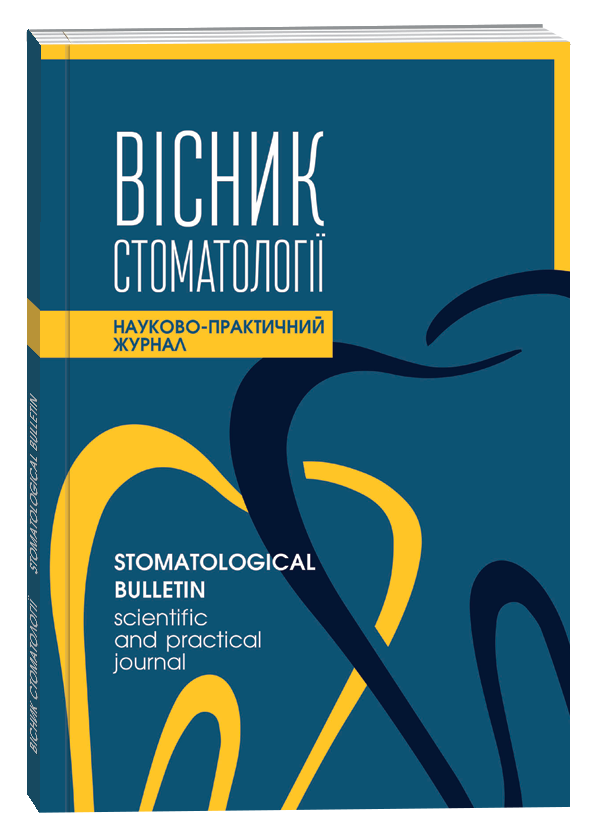PATHOLOGY OF VERTICAL DIMENSION OF OCCLUSION IN THE DEVELOPMENT OF FUNCTIONAL DENTOFACIAL DISORDERS
DOI:
https://doi.org/10.35220/2078-8916-2022-44-2.12Keywords:
occlusion, occlusion anomalies, preventive examination, orthodontic pathology, orthopedic pathology.Abstract
The purpose of the study is to substantiate the feasibility of a more comprehensive functional-diagnostic approach to the detection of functional disorders and conditions for their occurrence in different age and clinical groups based on the prevalence of pathology of vertical occlusion. Research methods. To achieve this goal, the data of the survey, dental examination with additional functional (electromyography and digital analysis of occlusion) examination of the dental status of 320 people (aged 25 to 60 years) were analyzed. Examinations were performed according to the generally accepted method in dentistry, which included the collection of complaints, life history and disease, external examination of the face and mouth. Additionally, functional diagnostic tests were performed: electromyography (EMG III, BioPack) and digital occlusion analysis (T-scan Novus). Also, the main condition for the study was to apply for dental care during the year, the presence of defects within the premolars or molars with their replacement by orthopedic structures and without. The materials of clinical and statistical research were subjected to variational-statistical processing in accordance with the purpose of our work. The results of the study were processed using generally accepted methods of mathematical statistics. Scientific novelty. With the help of modern methods, the objectivity of digital diagnostic methods and the need to develop new protocols for the rehabilitation of dental patients on the basis of quantitative indicators of diagnostic measures, rather than qualitative according to the classical approach. The issue of the prevalence of dental pathology by quantitative assessment is also considered. Conclusions. Our study found that 89.07 % of examined patients needed an additional diagnostic approach to detect dysfunction and assess the functional quality of restorative structures, which can not be assessed by classical static methods of assessing the functional dental status of the dental system due to their qualitative rather than quantitative assessment.
References
Dawson P. Functional occlusion from TMJ to smile design / Peter E. Dawson. – Mosby Elsevier. – St. Louis, 2006, 630 p.
Slavicek R. The masticatory organ Functions and disfunctions / Rudolf Slavicek. – Klosterneuburg : Gamma med-wiss Forbidungs-AG. 2006, 544 p.
Jeong M. Y., Lim Y. J., Kim M. J., & Kwon H. B. Comparison of two computerized occlusal analysis systems for indicating occlusal contacts. The journal of advanced prosthodontics, No. 12 (2), 2020. P. 49–54. https://doi.org/10.4047/jap.2020.12.2.49
Wetselaar P., Lobbezoo F., de Jong P., Choudry U., van Rooijen J., & Langerak R. A methodology for evaluating tooth wear monitoring using timed automata modelling. Journal of oral rehabilitation, No. 47 (3), 2020. P. 353–360. https://doi.org/10.1111/joor.12908
Wetselaar P., Wetselaar-Glas M., Katzer L. D., & Ahlers M. O. Diagnosing tooth wear, a new taxonomy based on the revised version of the Tooth Wear Evaluation System (TWES 2.0). Journal of oral rehabilitation, No. 47 (6), 2020. P. 703–712. https://doi.org/10.1111/joor.12972
Wetselaar P., Manfredini D., Ahlberg J., Johansson A., Aarab G., Papagianni C. E., Reyes Sevilla M., Koutris M., & Lobbezoo F. Associations between tooth wear and dental sleep disorders: A narrative overview. Journal of oral rehabilitation, No. 46 (8), 2019. P. 765–775. https://doi.org/10.1111/joor.12807
Di Palma E., Tepedino M., Chimenti C., Tartaglia G. M., & Sforza C. Longitudinal effects of rapid maxillary expansion on masticatory muscles activity. Journal of clinical and experimental dentistry, No. 9 (5), 2017. P. e635–e640. https://doi.org/10.4317/jced.53544
Mikami S., Yamaguchi T., Saito M. et al. Validity of clinical diagnostic criteria for sleep bruxism by comparison with a reference standard using masseteric electromyogram obtained with an ultraminiature electromyographic device. Sleep Biol. Rhythms. 2022. https://doi.org/10.1007/ s41105-021-00370-5
Ferrario V. F., Sforza C., Colombo A., Ciusa V. An electromyographic investigation of masticatory muscles symmetry in normo-occlusion subjects. Journal of Oral Rehabilitation. No. 27, 2000. P. 33–40.
Ramsay D. S., Rothen M., Scott J. M., Cunha- Cruz J., & Northwest PRECEDENT network. Tooth wear and the role of salivary measures in general practice patients. Clinical oral investigations, No. 19 (1), 2015. P. 85–95. https://doi.org/10.1007/s00784-014-1223-4
Agbaje J. O., Casteele E. V., Salem A. S., Anumendem D., Shaheen E., Sun Y., & Politis, C. Assessment of occlusion with the T-Scan system in patients undergoing orthognathic surgery. Scientific reports, No. 7 (1), 2017. P. 5356. https://doi.org/10.1038/ s41598-017-05788-x









